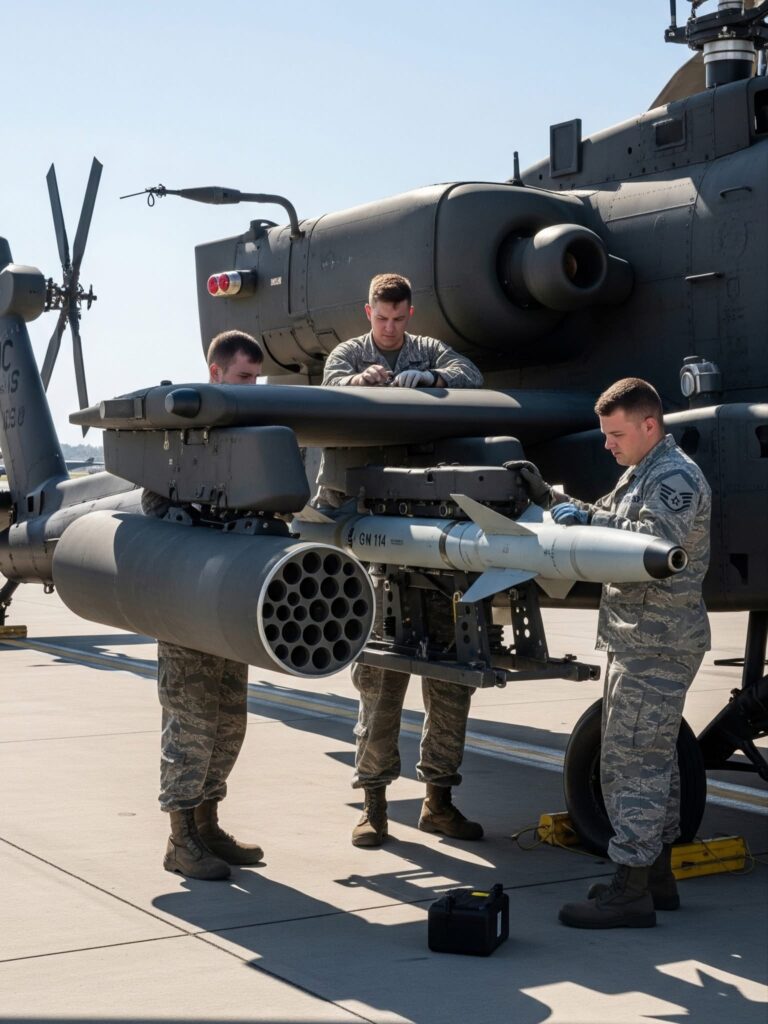
The AH-64 Apache attack helicopter is one of the most recognizable symbols of modern military power, and its effectiveness on the battlefield is amplified by the integration of the AGM-114 Hellfire missile. The Hellfire, designed primarily for anti-armor roles, has evolved into a versatile weapon capable of striking a variety of targets with precision. Installing these missiles onto the Apache is a meticulous process that blends technical precision, strict safety protocols, and mission-readiness procedures.
The first step in the installation process begins with preparation. Ground crews conduct a thorough inspection of both the aircraft and the munitions to ensure they are fit for loading. The missile is checked for any external damage, defects, or irregularities. Safety pins, protective covers, and shipping containers are examined and removed in a controlled manner. Simultaneously, the Apache undergoes a pre-loading inspection to confirm that its weapons pylons, launch rails, and electrical connections are in proper working order. This step is critical, as even minor discrepancies can result in a failure to fire or compromised targeting accuracy.

Once inspections are complete, the crew positions the missile for loading. The AH-64 Apache typically mounts its Hellfire missiles on a four-rail launcher known as the M299. Each launcher can accommodate up to four missiles, and the helicopter itself can carry multiple launchers across its stub wings. The missile is carefully aligned with the launcher rail before being slid into place. Ground crews use specialized tools and alignment procedures to ensure the missile locks securely onto the rail system. A distinct click or securing mechanism confirms that the missile is properly seated.
The next phase involves connecting the missile to the helicopter’s electronic systems. The AGM-114 relies on data and power provided by the aircraft to operate its guidance system, which can be laser-guided or radar-guided depending on the variant. Crews connect the umbilical cables, which transmit targeting data and system checks from the Apache to the missile. After the connection is established, technicians run diagnostic tests through the helicopter’s onboard systems. These tests verify communication between the aircraft and the missile, ensuring that the missile can receive targeting information and respond appropriately when commanded.

Safety is a dominant concern throughout this process. Strict adherence to explosive ordnance handling procedures prevents accidents. Ground personnel wear protective gear, follow step-by-step protocols, and maintain constant communication to reduce risks. The Apache itself remains powered down or in a controlled state during much of the loading sequence to prevent inadvertent activation of weapons systems. Additionally, all arming mechanisms within the Hellfire remain inactive until airborne crews deliberately engage them during combat operations.
Once all missiles are loaded and tested, final inspections are conducted. Ground crews confirm that each Hellfire is correctly mounted, connections are secure, and safety devices are in place. Only after these checks are completed is the Apache cleared for mission readiness. The crew chief documents the procedure, and the helicopter is prepared for deployment.

In summary, installing an AGM-114 Hellfire missile on an AH-64 Apache is not simply a matter of attaching a weapon; it is a deliberate and carefully regulated process. Every step—from inspection to connection, testing, and verification—is designed to ensure the missile functions as intended when the helicopter takes to the skies. This disciplined approach guarantees that the Apache retains its reputation as one of the most formidable attack platforms in modern warfare.




